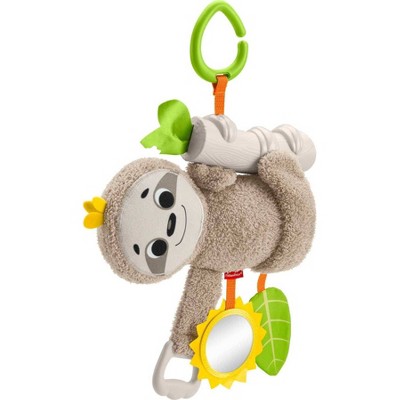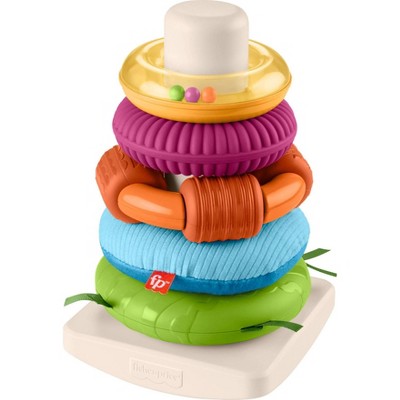Sponsored




Fisher-Price Rock-a-Stack Sleeve Infant Stacking Toy
In Stock
Sponsored
About this item
Highlights
- Classic infant stacking toy with 5 colorful rings to grasp, shake, and stack
- Top ring has shiny surface with rattle beads inside
- Roly-poly rocker base for wibbly-wobbly, bat-at play
- Helps develop fine motor skills and gross motor skills as baby grasps, shakes, and stacks the rings
- Great gift for babies and toddlers ages 6 months and older
- Smilestones: Bringing a smile to milestones! This toy helps foster Crawling by giving your baby colorful round targets to move toward
Description
Shipping details
Return details
Q: Is this product BPA and phthlate free? Does not say what material it is made out of? TIA
A: We design and engineer thousands of toys and children’s products, and each model is evaluated to make sure it meets stringent safety standards. Our internal product safety procedures are designed to meet or exceed regulations and laws enforced by the U.S. Consumer Product Safety Commission (CPSC) and their regulatory counterparts around the world. In toys, BPA is most often found in a material called polycarbonate, which is a very strong and clear plastic that is used in many products to prevent them from shattering or breaking. We set a standard that polycarbonate cannot be used in any product that is intended to be mouthed or touch food or made for a child under the age of 3, with the exception of power adapters and DVDs. For products with polycarbonate, we continue to pursue viable alternatives. For a closer look at our commitment to making safe and sustainable products, you can the Citizenship section of Mattel’s website.
submitted byMattel Consumer Services - 2 years agoBrand expertA: We design and engineer thousands of toys and children’s products, and each model is evaluated to make sure it meets stringent safety standards. Our internal product safety procedures are designed to meet or exceed regulations and laws enforced by the U.S. Consumer Product Safety Commission (CPSC) and their regulatory counterparts around the world. In toys, BPA is most often found in a material called polycarbonate, which is a very strong and clear plastic that is used in many products to prevent them from shattering or breaking. We set a standard that polycarbonate cannot be used in any product that is intended to be mouthed or touch food or made for a child under the age of 3, with the exception of power adapters and DVDs. For products with polycarbonate, we continue to pursue viable alternatives. For a closer look at our commitment to making safe and sustainable products, you can the Citizenship section of Mattel’s website.
submitted byFisher-Price - 6 years agoBrand expert
Q: Does this product contain BPA, BPA-like substances or phthalates? What type of plastic is used?
A: We design and engineer thousands of toys and children’s products, and each model is evaluated to make sure it meets stringent safety standards. Our internal product safety procedures are designed to meet or exceed regulations and laws enforced by the U.S. Consumer Product Safety Commission (CPSC) and their regulatory counterparts around the world. In toys, BPA is most often found in a material called polycarbonate, which is a very strong and clear plastic that is used in many products to prevent them from shattering or breaking. We set a standard that polycarbonate cannot be used in any product that is intended to be mouthed or touch food or made for a child under the age of 3, with the exception of power adapters and DVDs. For products with polycarbonate, we continue to pursue viable alternatives. For a closer look at our commitment to making safe and sustainable products, you can the Citizenship section of Mattel’s website.
submitted byMattel Consumer Services - 6 years agoBrand expertA: We design and engineer thousands of toys and children’s products, and each model is evaluated to make sure it meets stringent safety standards. Our internal product safety procedures are designed to meet or exceed regulations and laws enforced by the U.S. Consumer Product Safety Commission (CPSC) and their regulatory counterparts around the world. In toys, BPA is most often found in a material called polycarbonate, which is a very strong and clear plastic that is used in many products to prevent them from shattering or breaking. We set a standard that polycarbonate cannot be used in any product that is intended to be mouthed or touch food or made for a child under the age of 3, with the exception of power adapters and DVDs. For products with polycarbonate, we continue to pursue viable alternatives. For a closer look at our commitment to making safe and sustainable products, you can the Citizenship section of Mattel’s website.
submitted byFisher-Price - 6 years agoBrand expert
Q: Is this BPA-free? Can we get a direct yes or no answer. I’ve seen the long answer and don’t understand what that means.
A: Please rest assured that the well-being of your little one is always our main concern. Your trust is extremely important to us, and we will continue to make our toys as safe as possible. For a closer look at our commitment to making safe and sustainable products and for material-specific information, you can visit: https://corporate.mattel.com/product-quality-and-safety
submitted byMattel Consumer Services - 15 days agoBrand expert
Q: How would you recommend cleaning this toy before first use?
A: Clean with damp cloth and mild cleaner.
submitted byMattel Consumer Services - 1 year agoBrand expert
Q: What age is recommended?
A: Suggested Age: 6 Months and Up.
submitted byMattel Consumer Services - 1 year agoBrand expert
Q: Why is there a number stamped on the top ring? Is this safe for my baby to put in her mouth?
A: We design and engineer thousands of toys and children’s products, and each model is evaluated to make sure it meets stringent safety standards. Our internal product safety procedures are designed to meet or exceed regulations and laws enforced by the U.S. Consumer Product Safety Commission (CPSC) and their regulatory counterparts around the world. Please know our products are certified as 100% non-toxic, as safety is our top priority. Your trust is extremely important to us, and we will continue to make our toys as safe as possible for your little ones. For a closer look at our commitment to making safe and sustainable products and for material-specific information, you can visit the Citizenship section of Mattel's website. For additional questions, please call our Consumer Services team. They can be reached by phone at 1-800-432-5437 and are available Monday - Friday, between 9a.m. – 6p.m. EST.
submitted byMattel Consumer Services - 1 year agoBrand expert
Q: Where is this product made?
A: Mattel products are manufactured and packaged across the globe, in countries including Canada, China, Indonesia, Malaysia, Mexico, Thailand and the United States. These manufacturing operations occur in facilities owned and operated by Mattel as well as in our network of approximately 49 vendors worldwide. The product manufacturing location for a specific product can be found on the packaging.
submitted byMattel Consumer Services - 5 years agoBrand expert










